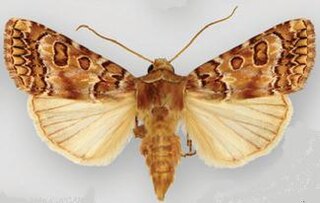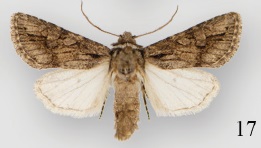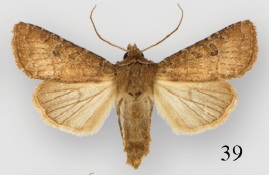
Hypotrix is a genus of moths of the family Noctuidae.

Hypotrix ferricola is a moth of the family Noctuidae first described by Smith in 1905. It is found in southern North America from south-eastern Arizona, south-western New Mexico and northern Mexico.

Hypotrix diplogramma is a moth of the family Noctuidae first described by William Schaus in 1903. It is found in southern North America from eastern Arizona and south-western New Mexico southward at least to Mexico City.

Hypotrix rubra is a moth of the family Noctuidae. It is found from south-western New Mexico and south-eastern Arizona southward to the State of Durango in northern Mexico.

Hypotrix spinosa is a moth of the family Noctuidae. It is a very rarely collected species that is known only from south-eastern Arizona, south-western New Mexico, and the State of Durango in northern Mexico.

Hypotrix basistriga is a moth of the family Noctuidae. It is known only from the White Mountains and Pinaleño Mountains in eastern Arizona.

Hypotrix naglei is a moth of the family Noctuidae. It is known from east-central Arizona, south-eastern Arizona, south-central New Mexico and south-western New Mexico.

Hypotrix alamosa is a moth of the family Noctuidae first described by William Barnes in 1904. It is known only from the United States in south-eastern Arizona.

Hypotrix trifascia is a moth of the family Noctuidae. It is found from southern Utah and Colorado southward through Arizona, New Mexico, and western Texas to northern Mexico.
Hypotrix vigasia is a moth of the family Noctuidae. It is found in Veracruz in south-eastern Mexico.

Hypotrix optima is a moth of the family Noctuidae. It is found from south-eastern Arizona and central New Mexico southward to Mexico City.

Hypotrix hueco is a moth of the family Noctuidae first described by William Barnes in 1904. It is known only from south-eastern Arizona in the United States.

Anhypotrix tristis is a moth of the family Noctuidae first described by William Barnes and James Halliday McDunnough in 1910. It is found from eastern Arizona and northern New Mexico southward in the Sierra Madre Occidental to the state of Durango in Mexico.

Protorthodes argentoppida is a moth in the family Noctuidae first described by James Halliday McDunnough in 1943. It has a limited range within North America, occurring in xeric forested areas of various mountain ranges in New Mexico and in the White Mountains in east-central Arizona.

Protorthodes oviduca, the ruddy Quaker moth, is a moth in the family Noctuidae. It is found across boreal and temperate areas of Canada and the northern United States with extensions in the eastern United States, ranging to central Florida and southern Alabama, and in the mountains in the West as far south as Colorado and Utah. In some areas it is found only in sandy habitats. The species was first described by Achille Guenée in 1852.

Protorthodes ustulata is a moth in the family Noctuidae first described by J. Donald Lafontaine, J. Bruce Walsh and Clifford D. Ferris in 2014. It is found in North America from south-eastern Wyoming southward to the Guadalupe Mountains in western Texas and westward to central and south-eastern Arizona and northern Mexico.
Homorthodes dubia is a species of cutworm or dart moth in the family Noctuidae. It was described by William Barnes and James Halliday McDunnough in 1912 and is found in North America.
Neleucania patricia is a species of cutworm or dart moth in the family Noctuidae. It is found in North America.

Lacinipolia triplehorni is a species of cutworm in the family Noctuidae. It is found in North America.

Tricholita chipeta is a species of cutworm or dart moth in the family Noctuidae. It was first described by William Barnes in 1904 and it is found in North America.









